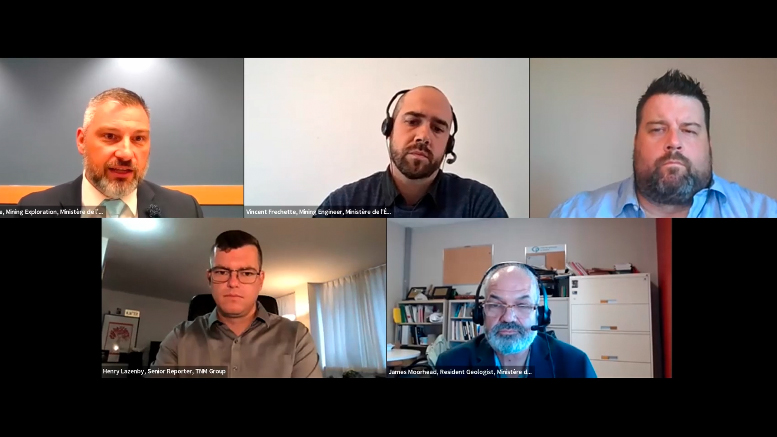The Quebec government has put in place specialized units to help mineral explorers, and mine developers navigate the province’s regulatory system from the discovery stage through production and closure, The Northern Miner’s recent Q3 Global Mining Symposium heard.
A thought leadership panel featuring four Quebec government representatives underlined the vast exploration potential in the province.
According to Jonathan Lafontaine, mining exploration activity monitor with the Ministère de l’Énergie et des Ressources naturelles, there currently are more than 220,000 active claims in the province, yet it only covers about 6% of the territory.
“There’s still lots of room and an incredibly vast space to explore,” he said.
According to government information, in 2021, exploration and development expenditures totalled about $964 million, placing it among the top Canadian destinations for mining investment.
Quebec has one of the most diverse commodity bases in the world, from precious metals, including gold, to bulks like high-grade iron ore and critical metals such as nickel, copper, and lithium. Quebec used to be a lithium producer and is now regaining that role. The panel also singled out the rare earth niobium as a high-potential commodity in the context of the energy revolution.
The province currently has about 22 mines in operation, three in care and maintenance and 33 mining projects. Some are driven forward by major players such as Rio Tinto (NYSE: RIO; LSE: RIO), Glencore (LSE: GLEN), ArcelorMittal, Newmont (TSX: NGT; NYSE: NEM), Agnico Eagle Mines (TSX: AEM; NYSE: AEM), and BHP (NYSE: BHP; LSE: BHP).
Dr. James Moorhead, the province’s resident geologist, said Quebec has one of the best geoscientific databases globally.
“The province’s large exploration potential is expressed yearly through the discoveries that keep coming,” he said.
Moorhead said gold attracts the lion’s share of exploration budgets, with about 70% of expenditures directed at finding and mining the yellow metal.
The panel stressed how all this activity was being made possible by the government’s proactive approach to making free high-quality geological survey datasets available to enable mineral discoveries.
“We receive about $12 to $16 million per year to send out geological survey teams of geologists to update our maps and to keep our data present,” said Moorhead.
Lafontaine said the government was eager to interact with companies to find a collaborative and successful outcome for the proponent.
“The idea is that we want to distribute this information as much as possible as easily as possible to various exploration groups. Exploration done on fundamental principles needs good data, and that’s what we strive to provide,” he said.
Top-tier jurisdiction
Vincent Fréchette, a mining engineer with the Ministère de l’Énergie et des Ressources naturelles, said Quebec has a well-developed and transparent regulatory and administrative system designed to assist miners in all phases, from exploration through development, operation and mine closure. It has helped the province earn a top-10 position in the Fraser Institute’s annual survey of mining investment attractiveness.
Aside from government vehicles designed to benefit from the mineral exploration and mining business, such as Investissement Québec and Soquem, he explained that the provincial government created a so-called Coordination Office three years ago to fast-track the mineral permitting process in Quebec.
“Through this office, we aim at ensuring a better management of timelines in issuing permits and optimize the exchange of information between proponents and departments,” he said.
The office currently has four projects on its desk. One of the cases is establishing interdepartmental tables that make it possible to offer the mining promoter a personalized level of support adapted to the regional realities, explained Fréchette.
He also explained how, in Quebec, the management of mining titles is computerized and easily accessible via the Internet.
The GESTIM website offers, through a geomatics application, instant access to updated data from the Register of Mining, Real and Immovable Rights of Quebec. GESTIM allows, among other things, to reduce the cost of acquiring and monitoring mining titles; consult and download data from the public register of mining rights by selecting the desired parameters; generate mining title maps adapted to one’s specific needs; view mining title maps and download them for free in PDF format; and to request a claim designation.


Be the first to comment on "GMS: Proactive Quebec government makes for a top-tier mining investment destination"